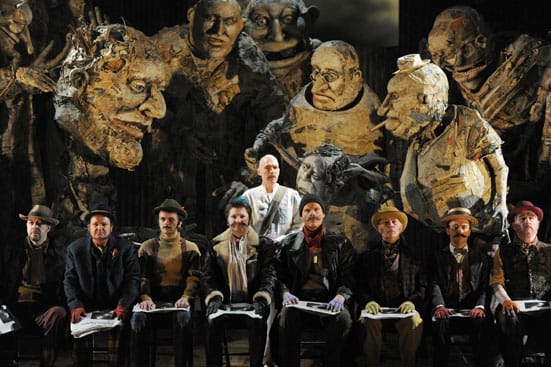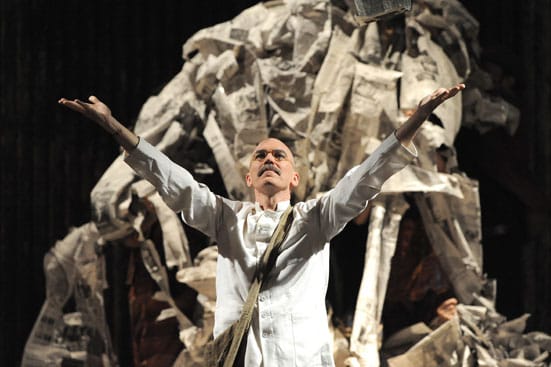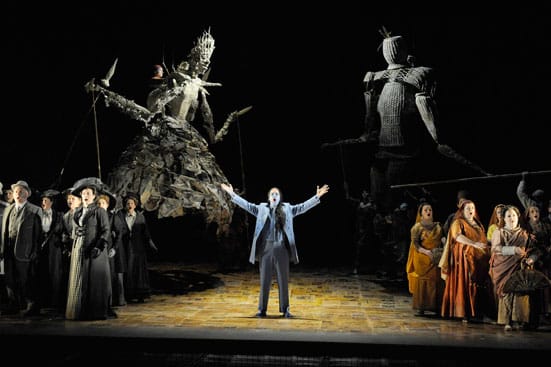25th February 2010 — 25th February 2010
In collaboration with Improbable.
A Co-Production with the Metropolitan Opera, New York.
Director: Phelim McDermott. Assistant Director / Set Design: Julian Crouch.
Conductor: Stuart Stratford. M K Gandhi: Alan Oke (Tenor).
Due to an excess of pleasant but inconsequential film score
work (aka Michael Nyman syndrome) Philip Glass's reputation as a serious
composer has declined somewhat in recent years in favour of the less easily
distracted (and arguably more talented) Steve Reich. Back in 1980 however,
following his rigorous Music In Twelve
Parts and the unquestionably innovative Einstein
On The Beach, Glass was very much the Minimalist ‘Man’ and it was in this
climate that he was commissioned to compose Satyagraha.
Eventually forming the centerpiece of his ‘personality trilogy’ of Operas,
alongside Einstein and the concluding
Akhenaten, Satyagraha was Glass's first exercise in traditional orchestration
(if you overlook the fact that he entirely dispenses with the brass section).
Not that this traditional element bleeds overmuch into the provenance of the
work itself. As with Einstein (a
libretto largely consisting of chanted numerals) Satyagraha is far from strictly operatic. The, loosely told, story
is that of Mahatma Gandhi's struggle to establish and develop his doctrine of
non-violent protest during his sojourn in South Africa which, in case you were
wondering, is where the big ‘S’ word comes in (literally ‘truth force’). Moving
on from Einstein Glass decided to
have this libretto sung in Sanskrit, not (as it turns out) as big an impediment
to enjoyment as one might fear, proving to be a richly resonant language.
Moreover, as the libretto itself, the text of which was sourced from the Bhagavada Vita by Constance De Jong,
largely consists of moralistic reflections, highly worthy but prone to impart a
sense of piety fatigue after a few hours, the usage of a dead language possibly
does some of us a slight favour.
Satyagraha's non-chronological scenes
are designed to illuminate the ideals of the doctrine rather than the specifics
of Gandhi's life and each of the three acts are informed by a spiritual
guardian (Tolstoy, Indian poet Tagore and Martin Luther King) who represent an
aspect of the Satyagraha process, thus rendering the work into a non-narrative
and stylised form. It is unsurprising, then, that much of the weight of a
convincing rendition of the piece falls upon imaginative staging. And
imaginative it is. The set design is kept suitably Spartan, thus reinforcing
the meditative nature of the text and the minimalist style of the score, but
the set changes themselves create beautiful, transformative atmospheres around
the central stasis of the piece. Within these parameters great ingenuity is
displayed, principally by use of the humble newspaper, suggestive of Gandhi's poverty, and
alchemised en masse by the cast into fans, screens, barriers, fountains and
fluttering animalistic shapes (and sometimes even just used as newspapers).
Strategic use is made of imposingly large, Gollum like papier maché figures
that, at certain crisis points, loom nightmarishly above the principal
characters, representing the violence proffered by those opposing Gandhi's
cause. A particularly affecting tableau is constructed midway through
Act3, where slow stepping figures stretch simple bands of tape across the
entire stage creating a tranquilising, luminous web-like environment. A
complete mood shift is then achieved by simple dint of the tapes being slowly
cut and adeptly fashioned into a vibrating version of one of the Gollums. It
could be argued that combining slowly moving performers with slowly moving
musical arpeggios is, in this neck of the woods, an enormous 80s cliché. But,
Hell, if it works this well, why change it?
Happily the musical performances are every bit the equal of the set design.
Alan Oke's tenor (as Gandhi) leads the cast with a smooth, plaintive, graceful
tone, standing out but never overwhelming his co-singers. The declamatory
beauty of Act 1, Scene 1’s The Kuru Field
Of Justice ,which slowly evolves into a male trio and is crucial to
establishing the tone of the whole performance, is a singularly well balanced
affair containing the essential blend of strength and gentleness that could stand proxy to the moral of the work
itself.
A more contentious note is struck by the pronounced vibrato utilised by all
three female leads. An unusual call, this, as the vocal oscillations involved
sit more awkwardly over the rapid ostinato passages of the music than purer tones might. There is, however,
no doubting the quality of the chorus. Consistently precise and passionate the
full chorus of Act 1 Scene 3's The Vow concludes that section of the work with breathtaking aplomb, fair blowing the
posh sock’s off of even those of us ‘up in the cheapies’.
Minimalism has, notoriously, been
tagged as a school of composition that has failed to achieve an entirely
‘mature’ phase. In 1980 Minimalist music, while not as strange a beast as it
was in 1970, was still cutting edge stuff but, inevitably, the ensuing years
have bred familiarity. The backing music to a thousand, serious minded,
documentaries has done for the genre what L’Oréal’s make-up graphics have done
to Mondrian’s art; half neutered it. How then has the piece stood the test of
time?
A few shortcomings do make themselves apparent. Firstly, the piece is somewhat
underwritten. This much was suspected back in the day but is now more
pronouncedly noticeable. In some sections that which once seemed daringly
repetitious now seems, simply, over repeated. There is also the issue of
dynamics, or lack of. Minimalist music is something of a pig to orchestrate, as
its fundamental reliance upon repeated motifs and rhythmic emphasis is more
naturally suited to smaller and more percussively orientated ensembles (I’m
taking the mild liberty of regarding keyboard instruments as being,
essentially, of the percussive persuasion). The additive, subtractive nature of
Minimalist compositions demand that any dynamic shifts be clear, noticeable ones;
thus leaving the composer with fewer orchestral cards to play in terms of
subtle changes of timbre (Mahler ; it’s not) and the, ensuing, ‘flattening’
effect throwing considerable weight upon the primary melody lines to remain
consistently and intrinsically interesting. Given his unknown track record up
to this point in his career Glass proves himself a remarkably strong melodicist,
revealing a Coplandesque liking for wide interval spaces during Act 2 and some
shades of Gorecki throughout the largely elegiac Act 3, although it’s also in
this (concluding) section of the work that he seems, at times, to have run out
of musically inventive steam.
As I suggested at the beginning; Glass may never quite have lived up to the high hopes that were entertained of him during this period. Much of his subsequent piano compositions (for example) have been exemplary, but for all of those, there’s been too much time spent on such projects as the Low Symphony; things certain to raise profile but intrinsically unlikely to accrue any true artistic weight. Lamentable as that is; Satyagraha remains a work of great emotional power and of continuing value. A tantalising pointer, perhaps, to what might have been.
Keiron Phelan
English National Opera
London Coliseum
St. Martin's Lane
London WC2N 4ES
http://www.eno.org/

Satyagraha
Alan Oke
Company 3
Credit Alistair Muir

Satyagraha
Alan Oke
Credit Alistair Muir

Satyagraha
James Gower Company
Credit Alistair Muir